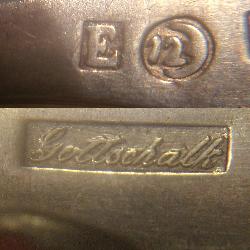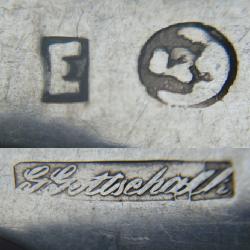“Gottschalk” Silversmith Germany?
Posted: Mon Jan 20, 2020 6:04 pm
Hello, I just got hold of a teaspoon that appears to be of 12 loth standard. The spoon has the surname “Gottschalk” stamped on it next to the number 12, but also there is extra personalisation featuring the date 1874.

I had a good look on line for “Gottschalk” and only found a Germany born “C.W. Gottschalk” as a mid 19th century Missouri, USA silversmith and jeweller. I know the 12 loth standard was typically a Germany centred standard but I also know some of the other Baltic nations measured their silver grade in loth or lodgit units. I am further muddled as the “Gottschalk” surname is also found in the populations of other Baltic nations.
I think I own a German spoon made around the 1870’s. Please forum, if necessary correct me, and hopefully fill in a lot more details.
I have had several late 19th century North European spoons with extra personalisation similar to this spoon. It seems, with the spoons I own, to be less frequently seen on the British ones. Was it a common practice over the other side of the North Sea? Was it a Christening practice? Is it valid dating evidence?
Fishless

I had a good look on line for “Gottschalk” and only found a Germany born “C.W. Gottschalk” as a mid 19th century Missouri, USA silversmith and jeweller. I know the 12 loth standard was typically a Germany centred standard but I also know some of the other Baltic nations measured their silver grade in loth or lodgit units. I am further muddled as the “Gottschalk” surname is also found in the populations of other Baltic nations.
I think I own a German spoon made around the 1870’s. Please forum, if necessary correct me, and hopefully fill in a lot more details.
I have had several late 19th century North European spoons with extra personalisation similar to this spoon. It seems, with the spoons I own, to be less frequently seen on the British ones. Was it a common practice over the other side of the North Sea? Was it a Christening practice? Is it valid dating evidence?
Fishless

